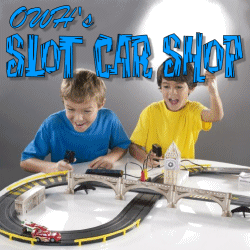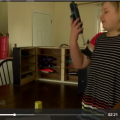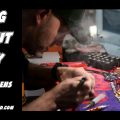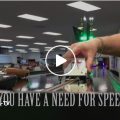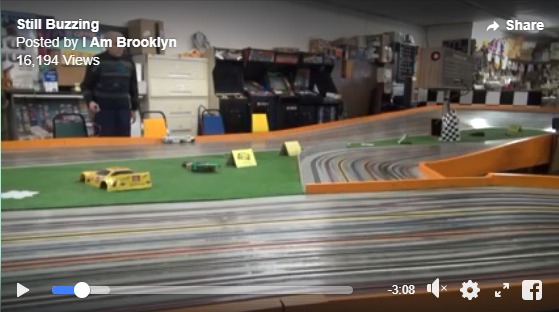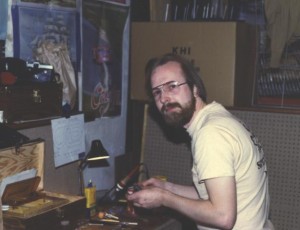
I don’t claim to be any sort of expert or top racer, but in my 50+ years of racing slot cars, I have learned a lot. While I actually have won a few “major” type races in my time, as well as plenty of local and regional type races over the years… I have probably learned most of my lessons the hard way – in the races I have lost. And I’ve lost plenty.
“If it’s true that you learn from your mistakes… then I oughta be a damned genius by now!” – Paul Kassens
I suspect that this may also be the case with a lot of the top pro racers as well, even if they might not like to dwell on that fact.
I’m sure multiple time National and World Champion Paul “Beuf” Pedersen has even learned a few lessons from races he actually lost… that is… IF he can remember back that far… LOL
So… I have been jotting down some of these little slot car pieces of wisdom, tidbits and tips, practical pointers, and peppered with some random thoughts, opinions, advice, and common sense… based on my experiences, both good and bad… of enjoying, racing, and competing in this fun but competitive hobby and sport of slot car racing.
BEEEEEP… beep… boop… Race ’em! 🙂
by Paul Kassens
The Old Weird Herald
Advice from an Old Weird Slot Car Racer
- If you want to get good advice from a top racer…. ask him AFTER the race. He’s MUCH more likely to share hot tips AFTER he just beat you.
- Always check your controller wires just before the power goes on. The 10 second beep works as an excellent reminder.
- Change your controller to the next lane IMMEDIATELLY after the power goes off for each heat, BEFORE staring at the lap counter. That way the next guy isn’t stuck standing there waiting for you, and can hook up HIS controller.
- NEVER lay your controller (or setup block, etc.) on the track. That one time you don’t pick it up in time when the power goes on… will be very bad.
- During the heat break… change your controller, change your sticker, check your braid, change your lane… THEN check the lap counter or mess with other stuff, during the remaining time.
- Ask questions about rules BEFORE you show up to race. Tech time is a bit late to find out that your car is illegal. Finding out at post-race tech is even worse.
- Always take your turn to corner marshal, if you expect others to marshal for you.
- Show up for the race early. This way you’ll have time to test & tune your cars. Once your cars are ready, then you can use this time to help out fellow racers who aren’t ready yet. Also – if you show up early – it’s often MUCH easier to find a pit space.
- When you solder on a pinion, clean the shaft and tin it. After you solder it on… take it back off and look at it. If it wasn’t all the way tinned, then you just saved your race, Guido. Now solder it on again, and get it right this time.
- Before teching your car in, check everything. Re-tighten set screws, check lead wires, guide self-centers, body pins, axle play, gear mesh, body doesn’t drag… everything. When you get up to qualify or race – you’ll be glad you did. If one of those things goes wrong in the race – you’ll WISH you did.
- Keep a spare pair of braid and some spare body pins handy. If you tape them to your controller or your shirt – you will always be able to find them in a hurry.
- Don’t forget to remove the spare braid & pins taped to your shirt after the race. While they may look rather fashionable at the track, they will not look nearly as cool to non-slot racers when you go out for a bite after the race.
- Be nice to the guy in the lane on your outside. Remember… in “European rotation”, he will be on your INSIDE later in the race. Remember: “What goes around comes around” and “Payback’s a bitch”.
- When catching up to a slower car next to you… it is often advisable to ask politely to “let me by on the straight?”, before merely slamming his car mercilessly into the wall.
- In open wheel slot car racing, just like it’s counterpart in 1/1 Indy or Formula 1 racing – passing in the corners can prove to be disastrous. You’ll never hear the catch phrase “Rubbin’ is racin'” uttered in open wheel racing.
- If you’re a new racer – offer to help clean lanes for an experienced racer. He’ll be a lot more likely to return the favor and help pit for you. If YOU are an experienced racer… offer to help pit for a new racer. You’ll probably need a lane cleaner later, and he might come in handy.
- Take apart your cars and clean them up AFTER the big race. This way they won’t rust and you’ll have more time to fix anything that needs fixing.
- Take apart your motors and send your armatures out for reconditioning AFTER your big race (not the week before the next big race). You’ll have much more time to get your motors rebuilt – and your favorite motor service will thank you for not waiting until the last minute when he’s more likely to be swamped.
- One of the biggest ironies in this hobby, is that in “wing car” racing you can see beautifully painted bodies by painters like Gil Rivera, “Smokin’ Joe” Redmond, Kenny Richins, and so many others – competing for Concours honors at big races like the Nats. Yet in “Scale” racing, which was originally intended to be a bit more “realistic” looking then wing cars, a two-color quickie paint job with three number stickers and a Sharpie outline on a same-color driver can win Concours at a major national or world championship race event. In spite of rumors or superstitions… it is simply not true that a nice paint job will jinx you or slow your car down. If in doubt, just ask Beuf.
- When you’re the new guy… be nice to the hotshot racers, and try to let them by without taking them out. Some day when you’re beating them, they’re likely to remember and be a lot nicer to you, and maybe they’ll even let YOU by without taking YOU out. (maybe)
I call it “slot car Karma”. - Paint your car in colors that you can see on the track. A black car on a black track is not only hard for YOU to see, but also hard for the other guys that slam into your car when they can’t see it.
- It’s a LOT easier to mount a body if you mask off a clear area where the pins go, when painting the body.
- Bullet proof your body. It’s a lot better to bullet proof it BEFORE it gets torn up in a race, then to patch it up with tape AFTER it gets thrashed.
- Always clean up your pit area before leaving the track. Your mother most likely does NOT work at the raceway, and even if she did, she would probably expect you to clean up your own damn mess.
- When changing lanes, do NOT just toss you old stickers on the floor. They are extremely hard to get off when stuck to the floor. If you must toss them, fold them in half first so they don’t stick. I always stick mine to the back of the sticker sheet, in the same location. It helps remind me which lane I’ve been in and going to, and I can reuse the stickers for club or weekly races if they still stick.
- Don’t just toss used braid on the floor. Stick it in your pocket or in your pits. A lot of braid used in races can get 1/8″ or so trimmed off and you can use them again! If you can afford to always use new braid, or prefer not to recycle… then give the used braid to a local young racer. I’m sure he would be glad to save some $ by trimming and reusing braid that was used in a race.
- Young racers can do well by volunteering to help clean up after a big race. Be sure to ask the track owner if it’s ok to keep what you find. Besides helping the track owner with the cleaning chore, you can usually find lots of braid, pins, and other various spare parts that are often useable again for practice. Traveling racers who notice you cleaning up may even give you other spares from their pits, rather then packing them up or throwing them away.
- When scrambling around the track during lane change breaks, try to remember “pass on the right” (at least in the USA anyway). This helps reduce on head on collisions and impromptu un-choreographed dancing maneuvers with other drivers.
- Complaining about a slot car raceway’s business practices is often a lesson in futility, as well as bad form. It is important to remember that most slot car raceways were opened with little or no actual plan to make a huge profit. Those that did, more then likely learned very soon that it ain’t so easy. Most raceways were started for the love of the hobby by slot car enthusiasts, and many changed ownership to rescue a raceway that was closing. Raceway owners could have made more from their investment and efforts in many other ventures. Try to keep this in mind if you find yourself disagreeing with how they run their races or raceway. You may not agree with everything they do… but you would miss them and regret not supporting them better if or when they close.
- Support your local raceway. Buy whatever slot car stuff you can from your local raceway. They have rent and overhead to cover to keep that track there so it’s there when you come to race or play. Remember that if they go out of business, all those slot cars, controllers, parts, and slot car tools, and supplies will not be much good without a track to use them at.
- If you race at multiple raceways, try to buy the stuff you use at each raceway that you race at. If you’re already “in the box” and ready to race when you arrive… then try to buy some stuff for your next race. This will help towards the raceway and track still being there for a future race.
- If you find a good deal on slot car stuff used or on eBay… try not to rub it in your track owners face. Remember that you can still make it up to him by buying all the stuff to fix or replace the obsolete crap you just wasted your money on buying on eBay. Keep in mind that if your local raceway closes… eBay doesn’t own any tracks you can race on (that is… unless you want to buy a used plastic home track…)
- When racing at a privately owned club or home track – keep in mind that you are a “guest”. Most of the same manners and etiquette apply to racing at a home or club track, as when you’re invited over for a dinner party. It would actually be nice if racers would remember to apply these same sort of courtesies when racing at commercial raceways as well…
- A messy pit is not necessarily a bad thing. What is MORE important is knowing where everything IS. I have seen many top racers with messy pits… but most top racers, regardless of whether they have a tidy or disheveled pit… do usually know where everything is.
- If you ever use or share another fellow racer’s pit space… ALWAYS be sure to put everything back EXACTLTY where you found it. Regardless of how messy it may look… moving tools in another racers pit, is about the same as rearranging furniture in a blind person’s house. In a meticulously neat person’s pit, moving tools would be more like rearranging a gourmet chef’s kitchen.
- Keeping an organized pit can be a very good habit. Try to be prepared for any emergency by having spares ready for every part on your car, and every tool you might need to fix it, just in case disaster should strike. Keep your soldering iron hot while racing, just in case. Having a spare or friend’s controller handy is also a good plan.
- A pit stop, whether under “green flag” racing or between heats, should be planned out and choreographed in advance… just as they do in “real” 1/1 racing. Every part and tool in it’s place, and everything done in a certain order, will help to prevent missing anything when the clock is ticking.
- Have a spare axle, gear, & wheel assembly ready to go. If you have the left wheel, gear, & spacer already on the axle, and the right wheel ready with an allen wrench in it… you can change the whole rear end faster then changing two wheels (and MUCH faster then if you just broke an axle or munched a gear!).
- For changing rear wheels or rear axle assembly… it’s faster if you use two allen wrenches (you can borrow a buddy’s wrench who’s in a different heat). Have one wrench already stuck in the new wheel, and the other one ready to take off the old wheel. Swap & repeat, or use three wrenches if just changing wheels.
- Always “Blueprint” your car before racing it. “Blueprinting” means basically to: check, clean, straighten, flatten, align, brace, solder, bullet proof, set clearance, set gear, axle, guide, armature, & chassis “play”, tighten set screws, clean up & oil, etc. prior to racing for the first time as well as before each race.
- Try to stick around and pay attention when the race director is getting lane choices after qualifying for the race. It saves a lot of time and frustration if he doesn’t have to wait until you get back from the parking lot, then having to repeat what lane’s are taken and what’s available for each person before they choose their lane. It also helps to have your sticker sheet handy to help “visualize” the choices and lane rotation when you pick. Take your smoke or lunch break AFTER you get your lane pick.
- While driving in a slot car race, it’s always good to keep the turn marshals in your peripheral vision. If a marshal makes a sudden move, it’s a good time to let up and look ahead for traffic. If you hear a loud crash… then it’s an even better idea to slow down and take a gander at what’s up ahead.
- In a race, you’d have to go around .2 seconds per lap faster for an entire heat to make up for just one crash… based roughly on a 3 minute heat at 5 seconds per lap. If you crash twice, you’d have to shave a half second off your lap times for an entire heat to make up for the lost time. Staying in the slot has a lot more effect on your lap totals then just going fast.
- When you’re just getting started – you can improve your lap totals a lot more by practicing and improving your driving – then by just spending money on faster cars, motors, controllers, and gadgets.
- Once you can go an entire 3 minute heat without falling off… then you can work on improving your lap times and total laps.
- As in many things in life… the decision on whether to buy verses build your own slot cars, motors, & chassis… depends on which you have more of – money or time.
- Traveling to and attending The Nats, or any big race, is something every slot car racer should experience if at all possible. You get a chance to meet other fellow racers from other areas of the country or world. It is great to see and learn some of the different tricks from other racers, and great to make new friends who share this hobby!
- When attending The Nats – or any big race… it is not recommended to sleep at the track, even under grueling schedules, and especially if Gugu is present! Playing pranks on dozing racers is quite common, and Gugu is the master prankster!
- When traveling to a big slot car race by plane… it is often better to take your slot cars as carry-on baggage. You can put the tools in with your clothes, because they will not be allowed in carry-on bags, and you can check in the bag with the clothing and tools. Here’s the reasoning… If you check in your slot cars and carry your clothes… and your bag gets lost… then at least will have fresh clothes to wear while turn marshaling. But if you check your clothes and carry your cars and parts… then you might have to wear the same clothes… but at least you’ll be racing. You can always borrow tools… and buy a new T-shirt or stick of deodorant… but it’s much harder to borrow a whole racing program.
- Keep in mind that slot car racing is both a hobby and a sport. Some people are in it mostly for the sport – the thrill of competition. Others enjoy it more as a hobby – collecting, designing, building, painting… the modeling aspects. What’s really cool about slot car racing – is that you can enjoy BOTH.
- Another thing that is special about slot car racing, is the social aspect. In many hobbies, people often organize clubs to meet, socialize, and make friends with others who share their hobby. In slot car racing… the races and the raceways and club tracks ARE the social group where you meet friends who enjoy the same hobby!
by Paul Kassens
www.oldweirdherald.com
www.slotcartalk.com/slotcartalk







